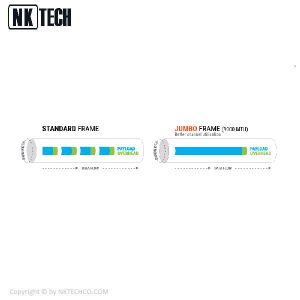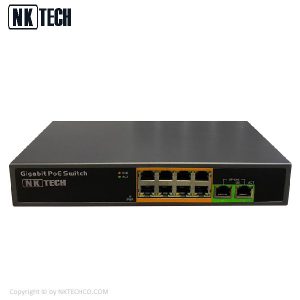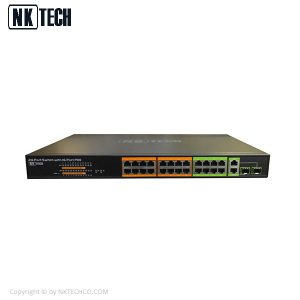Jumbo frame چیست؟
Jumbo frame چیست؟
در ابتدای مقاله فریم جامبو لازم است که
درباره ی مدل هفت لایه ای OSI صحبت کنیم.
مدل مرجع OSI
در این استاندارد تمام وظایف و خدمات یک شبکه در یک
مدل هفت لایه ای تحت عنوان مدل هفت لایه ای OSI تعریف شده :
- لایه فیزیکی Physical Layer
- لایه پیوند داده Data Link Layer
- لایه شبکه Network Layer
- لایه انتقال Transport Layer
- لایه نشست Session Layer
- لایه نمایش (ارائه ) Presentation Layer
- لایه کاربردی Application Layer
برای اینکه طراحی شبکه ها سلیقه ای و پیچیده نشود
سازمان جهانی استانداردسازی (ISO ) مدلی هفت لایه ای برای شبکه ارائه کرد
به گونه ای که وظایف و خدمات شبکه در هفت لایه مجزا تعریف و ارائه می شود.
این مدل هفت لایه ای مدل مرجع OSI یا Open System Interconnection نام گرفت .
این مدل ابتدا در دهه هشتاد معرفی و بار دیگر در سال ۱۹۹۵ مورد بازنگری قرار گرفت
تا با پیشرفت علم شبکه , در طول زمان تطبیق پیدا کند .
هرچند درشبکه اینترنت از این مدل استفاده نمی شود و
به جای آن از مدل چهار لایه ای به نام مدل TCP/IP تعریف شده است .
ولی بررسی مدل هفت لایه OSI به دلیل دقت زیادی که
در تفکیک و تبیین مسائل شبکه در آن وجود دارد , با ارزش است .
برای مطالعه ادامه مقاله کلیک کنید.

Jumbo frame چیست؟
payload یا پیلود چیست ؟
نامگذاری بسته های اطلاعاتی در لایه های مختلف های متفاوت است.
در لایه سوم بسته های اطلاعاتی به نام Packet شناخته شده و
در لایه دوم به Frame معروف است، حال به میزان داده ای که در یک
بسته اطلاعاتی Frame قرار می گیرد با عنوان Payload نامگذاری شده است.
برای انتقال Payload ها در شبکه لایه های OSI ایجاد شد.
Jumbo frame چیست؟
قاب جامبو یک قاب اترنت است که دارای محموله ای بیشتر
از حداکثر واحد انتقال استاندارد (MTU) 1500 بایت است.
Jumbo Frame یعنی یک Ethernet Frame موجود است که
میزان Payload آن از MTU پیشفرض شبکه بیشتر است یعنی ۱۵۰۰ بایت است .
درواقع فریم در شبکه اینطور معرفی می شود به واحدهای انتقال اطلاعات در لایه Link.
فریمها شامل بیتهایی دیتا یا همان payload هستند.
دیتای اصلی یا پیام مدنظر برای انتقال payload است.
فریم های جامبو در شبکه های محلی که حداقل ۱ گیگابیت بر ثانیه را پشتیبانی می کنند
و تا ۹۰۰۰ بایت می توانند استفاده شوند.
از آنجا که فریم های جامبو در مشخصات IEEE 802.3 برای اترنت
تعریف نشده است ، پشتیبانی فروشنده از قاب های جامبو و
حداکثر واحدهای انتقال آنها ممکن است متفاوت باشد.
چون فریم های جامبو بر اساس IEEE 802.3 اترنت تعریف نشده است،
فروشنده می تواند از فریم های جامبو و حداکثر واحد انتقال بیشینه
مختلفی را پشتیبانی کند. شما می توانید با استفاده از ایجاد یک
روش انتقال کاربردی تر از طریق فعال کردن فریم های جامبو عملکرد شبکه را بهبود ببخشید.
فریم جامبو چیست؟
پردازنده هایی که روی سوئیچ ها و روترها سوار هستند قادرند
تنها یک فریم را به طور هم زمان مورد پردازش قرار دهند.
شما می توانید ظرفیت ترابری بیشتری در هر فریم قرار دهید تا از این طریق
پردازنده ها فریم کمتری برای پردازش داشته باشند.
مزیت استفاده از این روش کاهش میزان گرمای دستگاه های شبکه است.
فریم های معمولی از ۶۴ الی ۱۵۱۸ بایت پشتیبانی می کنند. مقدار نانبرده شده
در هر فریم برای کاربردها عمومی به اندازه می باشد. اگر کاربر به انتقال فایل های بزرگتر
در شبکه نیاز پیدا کند، این فایل ها را باید به تعدادی زیادی پکت های عادی تبدیل نمود.
با پیشرفت تکنولوژی شما می توانید از جامبو فریم استفاده کنید
که فریم ها تا ۹۶۰۰ بایت قابل ارسال باشند.
پس با این روش می توان برای ارسال یک فایل با حجم بالا تعداد کمتری فریم ارسال کرد.
در اینجا ما به معرفی چند سوئیچ که از فریم جامبو پشتیبانی می کنند می پردازیم.
سوئیچ شبکه PoE انکاتک مدل PSE1008G
سوئیچ شبکه PoE انکاتک مدل PSE1008G تولید شده در شرکت انکاتک
که سوئیچ های با قابلیت PoE تولید می کند ، این قابلیت می تواند
جریان برق را در کابل های شبکه برقرار کند و برق مصرفی خود را
از همان کابلی که به شبکه متصل کرده است تغذیه می نماید
در این صورت باید از کابل های با کیفیت استفاده شود
که در صورت افت ولتاژ در کار این سوئیچ اختلالی ایجاد نشود .
برای دیدن مشخصات فنی این سوئیچ کلیک کنید.

سوئیچ شبکه PoE انکاتک مدل PSE1008G
سوئیچ شبکه PoE انکاتک مدل NKTECH PS2616GSR
سوئیچ شبکه PoE انکاتک مدل PS2616GSR از سوئیچ های تولید
شرکت انکاتک می باشد که ویژگی سوئیچ های این شرکت پشتیبانی
از قابلیت PoE می باشد و به سبب این ویژگی جریان برق در
کابل های شبکه بدون اتصال به پریز برق برقرار می کند که موجب
صرفه جویی در انرژی برق می شود . این سوئیچ شبکه دارای ۲۶ پورت
با سرعت ۱۰/۱۰۰ ، ۲ پورت با سرعت ۱۰/۱۰۰/۱۰۰۰ و ۲ پورت SFP می باشد .
از ویژگی های دیگر این سوئیچ می توان به پهنای باند داخلی ۳۵۰ وات ،
ابعاد ۴۴*۲۱۰*۴۴۰ میلی متر و می تواند به راحتی در رک مونت ها نصب شود .
برای دیدن مشخصات فنی این سوئیچ کلیک کنید.

سوئیچ شبکه PoE انکاتک مدل NKTECH PS2616GSR
مزایای استفاده از فریم های جامبو
مهمترین مزیت استفاده از فریم جامبو بهره وری بیشتر در انتقال داده ها است.
پس لازم است که درباره ی کارایی مربوط به فریم جامبو بیشتر توجه کنید
زیرا شما را قادر به انتقال اطلاعات بیشتر در هر فریم می کند.
در اینجا به معرفی چند مورد کاربرد می پردازیم
که می توانند از فریم های جامبو بهره ببرند.
NFS (سیستم فایل شبکه).
از این پروتکل برای به اشتراک گذاشتن فایل ها در شبکه استفاده می شود ،
شما می توانید با به کاربردن و استفاده
از فریم های بزرگ می توان عملکرد شان را بهبود ببخشید.
ISCSI SAN یا FCOE
کارایی این پروتکل به این شکل است که با ذخیره سازی اترنت نیاز
به انتقال بیشتر روی سیم دارد. شما با استفاده از دستگاه هایی
که از فریم جامبو پشتیبانی می کنند، می توانید به عملکرد آنها بهبود ببخشید.
در ادامه منبع مقاله های نوشته شده را می آوریم.
jumbo frames
A jumbo frame is an Ethernet frame with a payload greater than the standard maximum transmission unit (MTU) of 1,500 bytes.
Jumbo frames are used on local area networks that support at least 1 Gbps and can be as large as 9,000 bytes. Because jumbo frames are not defined in the IEEE ۸۰۲٫۳ specifications for Ethernet, vendor support for jumbo frames and their maximum transmission units may vary.
Enabling jumbo frames can improve network performance by making data transmissions more efficient. The CPUs on switches and routers can only process one frame at a time. By putting a larger payload into each frame, the CPUs have fewer frames to process. In return, this can reduce the amount of heat the network devices generate.
Jumbo frame چیست؟
These gains are only realized, however, if each link in the network path — including servers and endpoints — is configured to enable jumbo frames at the same MTU. Otherwise, performance may actually decrease as incompatible devices drop frames or fragment them, the latter of which can task the CPU with higher processing requirements. Enabling jumbo frames may also increase packet loss rates.
Background
Ethernet traffic moves in units called frames. The maximum size of frames is called the Maximum Transmission Unit (MTU). When a network device gets a frame that is larger than its MTU, the data is either fragmented into smaller frames, or dropped. Historically, Ethernet has a maximum frame size of 1500 bytes. An Ethernet packet larger than 1500 bytes is called a jumbo frame.
An Ethernet frame uses a fixed-size header. The header contains no user data, and is overhead. Transmitting a larger frame is more efficient, because the overhead-to-data ratio is improved.

Guidance on the use of jumbo frames
Performance problems arise when the MTU of one device is different from the MTU of another. Making casual changes to MTU to optimize performance is likely to have the opposite effect of decreasing performance.
If most of your local network devices and applications can be configured for the same jumbo frame size, your network might benefit from larger packets, less fragmentation, and less overhead. In modern equipment, this optimization is becoming less of a problem due to LSO/LRO and TCP offload engines, especially on higher end server grade NICs.
All equipment on the same layer 2 network, which means the same LAN or VLAN, should support the same frame size. By default, this is 1500 bytes. If you increase the MTU on one of your end devices, your switch needs to be able to pass these larger frames (same frame size or larger, than default MTU), and the receiving end needs to handle these larger frames as well. If this change is not coordinated, your network might actually run slower, or break.
When should jumbo frames be used?
Use jumbo frames only when you have a dedicated network or VLAN, and you can configure an MTU of 9000 on all equipment, to increase performance. A good example of this approach is a separate SAN or storage network. In all other situations, the effort of configuring jumbo frames everywhere on your network is not worth the marginal improvement, and has the potential of slowing down or breaking non-jumbo frame clients.
Jumbo frame
In computer networking, jumbo frames are Ethernet frames with more than 1500 bytes of payload, the limit set by the IEEE 802.3 standard.[1] Commonly, jumbo frames can carry up to 9000 bytes of payload, but smaller and larger variations exist and some care must be taken using the term. Many Gigabit Ethernet switches and Gigabit Ethernet network interface controllers can support jumbo frames. Some Fast Ethernet switches and Fast Ethernet network interface cards can also support jumbo frames.[2]
Inception
Each Ethernet frame must be processed as it passes through the network. Processing the contents of a single large frame is preferable to processing the same content broken up into smaller frames, as this makes better use of available CPU time by reducing interrupts. This also minimizes the overhead byte count and reduces the number of frames needing to be processed.[3] This is analogous to physically mailing a packet of papers instead of several single envelopes with one sheet each, saving envelopes and cutting sorting time.
Jumbo frames gained initial prominence in 1998, when Alteon WebSystems introduced them in their ACEnic Gigabit Ethernet adapters.[4] Many other vendors also adopted the size; however, jumbo frames are not part of the official IEEE 802.3 Ethernet standard.
What jumbo frames are
Jumbo frames are larger than standard frames and require fewer frames. Therefore, you can reduce the CPU processing overhead by using jumbo frames with your network interfaces. Particularly, by using jumbo frames with a Gigabit or 10 Gigabit Ethernet infrastructure, you can significantly improve performance, depending on the network traffic.
Jumbo frames are packets that are longer than the standard Ethernet (IEEE 802.3) frame size of 1,518 bytes. The frame size definition for jumbo frames is vendor-specific because jumbo frames are not part of the IEEE standard. The most commonly used jumbo frame size is 9,018 bytes.
What jumbo frames are
Jumbo frames can be used for all Gigabit and 10 Gigabit Ethernet interfaces that are supported on your storage system. The interfaces must be operating at or above 1,000 Mbps.
You can set up jumbo frames on your storage system in the following two ways:
- During initial setup, the setup command prompts you to configure jumbo frames if you have an interface that supports jumbo frames on your storage system.
- If your system is already running, you can enable jumbo frames by setting the MTU size on an interface.

